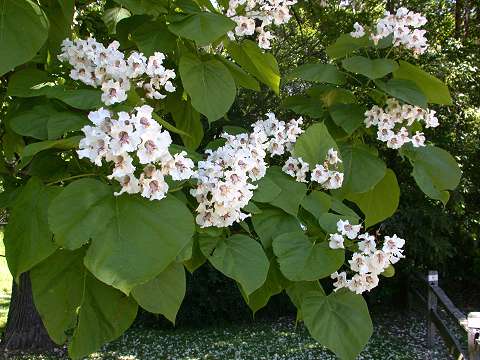

Catalpa speciosa - (image 1 of 5)
Taxonomy
Family: Bignoniaceae
Habitat
Native to the southern U.S. where it occurs in alluvial forests. Tends to occur in weedy areas further north where it has been introduced. A common habitat is along railroads.
Associates
Tend to be weedy in the north. Native associates include Acer negundo, Ambrosia artemisiifolia, Aster pilosus, Erigeron canadensis.
Distribution
Southern IN to AR and TX. Naturalized further north and east.
Morphology
Deciduous tree to 30 m; trunk well-developed; stems with no terminal bud. Leaves alternate, to 30 cm (shade leaves larger than sun leaves), heart-shaped and long-acuminate, hairy beneath. Flowers are large and showy; inflorescence to 20 cm; corolla white, marked with 2 yellow stripes and pale purple spots. Fruit to 1.5 cm wide and 50 cm long, with a stout quadrangular placenta; seeds 2.5 cm, with wings rounded at the end and a flat fringe of hairs.
Notes
Flowers late May to early July
Wetland indicator: Facultative Upland
Once popular as an ornamental due to it's fast growth when young and showy flowers in mid summer. Tree can be surprisingly long-lived and sturdy, although it is somewhat messy.
References
Gleason, Henry A. and A. Cronquist. 1991. Manual of Vascular Plants of Northeastern United States and Adjacent Canada. Second Ed.
The New York Botanical Garden. Bronx, NY
Swink, F. and G. Wilhelm. 1994. Plants of the Chicago Region.
Indiana Academy of Science. The Morton Arboretum. Lisle, Illinois.
|
© Michael Hough 2004 |